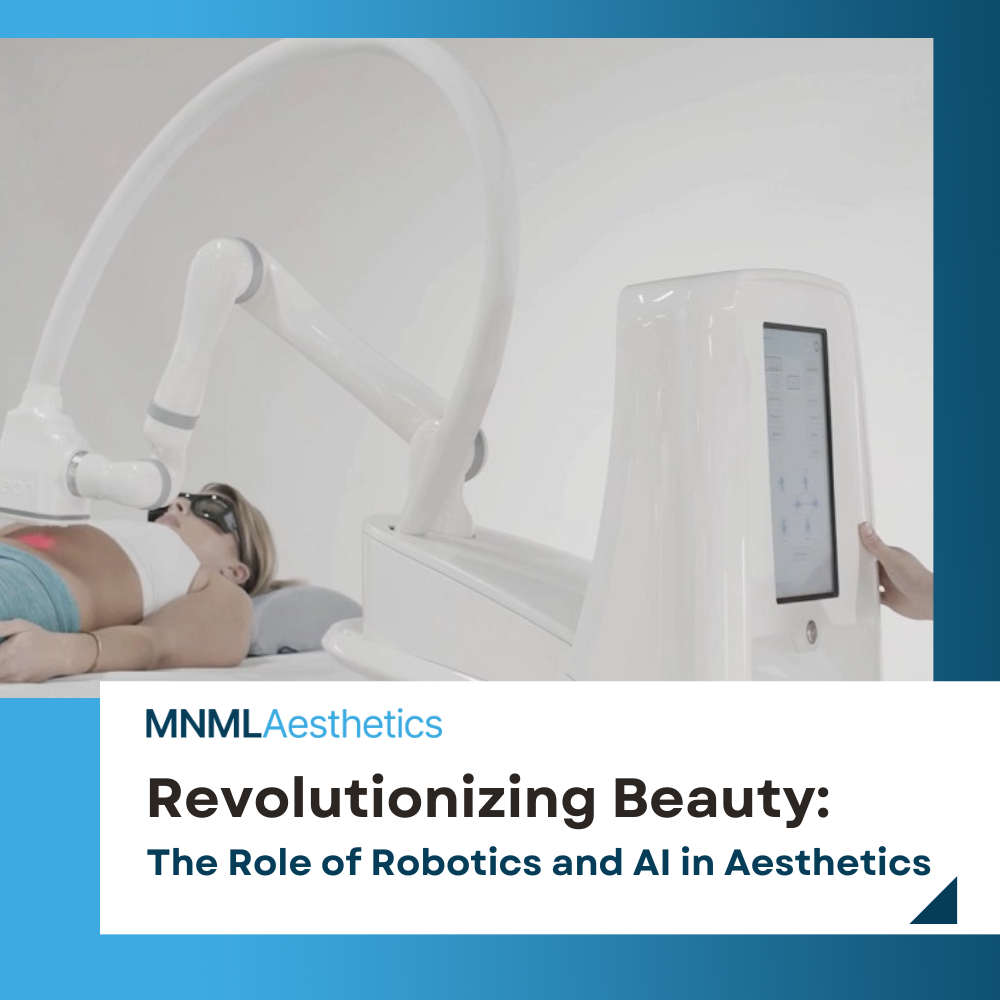The field of medical aesthetics is experiencing a remarkable transformation, thanks to the integration of robotics and artificial intelligence (AI). These cutting-edge technologies are enhancing precision, safety, and personalization in various aesthetic treatments, making procedures more effective and accessible. At MNML Aesthetics, we are committed to embracing these advancements to provide our clients with the best possible care. In this blog, we will explore how robotics and AI are revolutionizing the world of aesthetics and what it means for the future of beauty.
The Intersection of Robotics and AI in Aesthetics
Robotics and AI are two powerful technologies that, when combined, offer unprecedented capabilities in the field of aesthetics. While robotics brings automation and precision, AI contributes intelligent decision-making and personalized treatment plans. Together, they are redefining how aesthetic procedures are performed and experienced.
Key Technologies and Their Applications:
- Robotic-Assisted Procedures: Robots assist in performing minimally invasive and non-invasive aesthetic procedures with high precision and consistency.
- AI-Driven Diagnostics and Treatment Planning: AI algorithms analyze patient data to create personalized treatment plans, improving outcomes and patient satisfaction.
- Automated Injection Systems: Robotic devices administer injectables like fillers and Botox with exacting accuracy, reducing discomfort and enhancing results.
- Laser and Light-Based Systems: Robotic systems ensure uniform application of laser and light treatments, enhancing safety and efficacy.
Benefits of Robotics and AI in Aesthetics
1. Enhanced Precision and Consistency
Robotics and AI enable unparalleled precision in aesthetic procedures. Automated systems perform tasks with micron-level accuracy, ensuring consistent and optimal results. This precision is crucial for treatments like injectable procedures and laser therapies, where even minor deviations can significantly impact outcomes.
2. Improved Safety
Robotic systems reduce human error, minimizing the risk of complications and enhancing patient safety. Features such as real-time monitoring and feedback allow for immediate adjustments during procedures, ensuring the highest safety standards.
3. Personalized Treatment Plans
AI-driven systems analyze individual patient data, including skin type, medical history, and aesthetic goals, to create highly personalized treatment plans. This level of customization leads to better results and higher patient satisfaction.
4. Reduced Downtime and Faster Recovery
Many robotic-assisted procedures are minimally invasive, causing less trauma to the body. This results in reduced downtime and faster recovery for patients, allowing them to resume their daily activities sooner.
5. Enhanced Patient Experience
The integration of robotics and AI enhances the overall patient experience. Automated systems perform procedures with greater comfort and less pain, and the efficiency of these technologies reduces treatment times.
Applications of Robotics and AI in Aesthetics
1. Robotic Hair Restoration
Robotic hair restoration systems, such as ARTAS, use advanced imaging and precision robotics to perform hair transplant procedures. These systems can identify the best hair follicles for transplantation, ensuring natural-looking results with minimal scarring.
2. Automated Injectable Treatments
Robotic injection devices, like the AQUAGOLD fine touch, deliver microinjections of fillers, Botox, and other treatments with exceptional precision. These devices can treat large areas quickly and uniformly, reducing discomfort and achieving consistent results.
3. Robotic-Assisted Liposuction
Robotic-assisted liposuction systems enhance the accuracy and control of fat removal procedures. By precisely targeting and removing fat cells, these systems help sculpt the body with minimal invasiveness and faster recovery times.
4. Laser and Light Therapy
Robotic systems in laser and light therapy ensure uniform application and optimal settings for each treatment session. This technology is used in procedures such as laser skin resurfacing, hair removal, and photofacials, improving efficacy and safety.
5. AI-Powered Skin Analysis
AI-driven diagnostic tools analyze skin conditions in detail, providing accurate diagnoses and personalized treatment recommendations. These systems assess various skin parameters, including texture, pigmentation, and elasticity, to develop customized skincare plans.
The Future of Robotics and AI in Aesthetics
The integration of robotics and AI in aesthetics is still in its early stages, but the potential is immense. As these technologies continue to advance, we can expect even more sophisticated systems that further enhance precision, safety, and personalization in aesthetic treatments. The future may see fully automated clinics where robots handle everything from diagnosis to treatment, offering unparalleled efficiency and consistency.
At MNML Aesthetics, we are excited to be at the forefront of this technological revolution. We are committed to adopting the latest innovations to provide our clients with the highest standards of care and the best possible results.
Conclusion
Robotics and AI are revolutionizing the field of medical aesthetics, bringing enhanced precision, safety, and personalization to various treatments. These technologies are not only improving outcomes but also transforming the overall patient experience. At MNML Aesthetics, we are dedicated to leveraging these advancements to help our clients achieve their beauty and wellness goals.
For more information on our range of robotic-assisted and AI-driven aesthetic treatments, visit www.mnmlaesthetics.com and follow us on our social platforms to stay updated on our latest offerings. Let us help you discover the future of beauty with cutting-edge technology.

